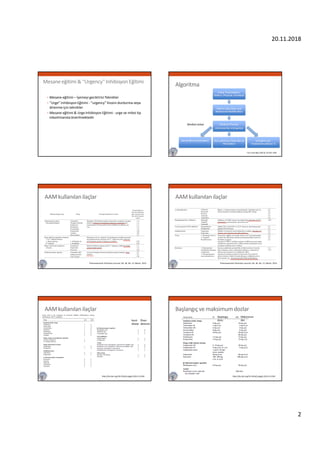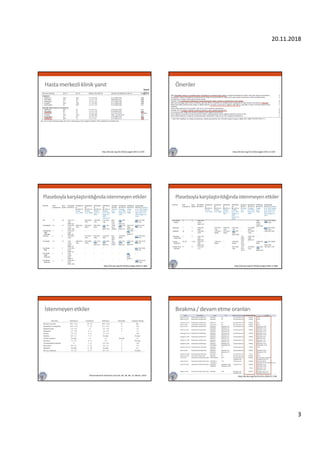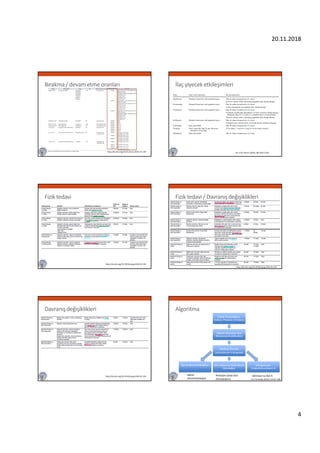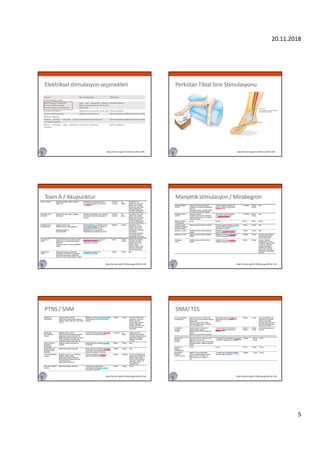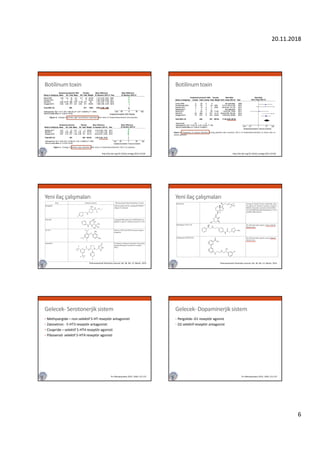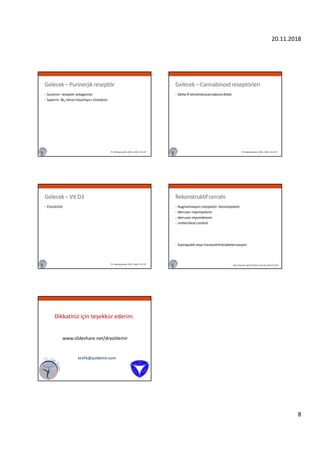Management of overactive bladder
- 1. 20.11.2018 1 A┼¤─▒r─▒ Aktif Mesane G├╝ncel Y├Čnetim Dr. Tevfik Yoldemir BBA, MSc Marmara ├£niversitesi T─▒p Fak├╝ltesi www.yoldemir.com Algoritma Curr Urol Rep (2013) 14:541ŌĆō548 ├¢yk├╝, Fizik muayene ve ─░drar tahlili Ya┼¤amkalitesi / Sa─¤l─▒kla ilgili Ya┼¤am kalitesi doi:10.1016/j.urology.2009.07.1325 AAMile birlikteg├Čr├╝lendurumlar http://dx.doi.org/10.5489/cuaj.3962 Algoritma Curr Urol Rep (2013) 14:541ŌĆō548 Hasta E─¤itimi ve Davran─▒┼¤ De─¤i┼¤iklikleri Davran─▒┼¤tedavileri ŌĆó S─▒v─▒ y├Čnetimi ŌĆó ─░┼¤eme s─▒kl─▒─¤─▒ ŌĆó Tuvalet yard─▒m─▒ ŌĆó Programl─▒ tuvalete gitme ŌĆó Zamanl─▒ i┼¤eme ŌĆó Mesane e─¤itimi ŌĆó Pelvik taban kas egzersizleri
- 2. 20.11.2018 2 Mesanee─¤itimi & ŌĆ£UrgencyŌĆØInhibisyonE─¤itimi ŌĆó Mesane e─¤itimi ŌĆō ─░┼¤emeyi geciktirici Teknikler ŌĆó ŌĆ£UrgeŌĆØ Inhibisyon E─¤itimi - ŌĆ£urgencyŌĆØ hissini durdurma veya direnme i├¦in teknikler ŌĆó Mesane e─¤itimi & Urge Inhibisyon E─¤itimi - urge ve mikst tip inkontinansta ├Čnerilmektedir Algoritma Curr Urol Rep (2013) 14:541ŌĆō548 Medikal tedavi AAMkullan─▒lanila├¦lar Pharmaceutical Chemistry Journal, Vol. 46, No. 12, March, 2013 AAMkullan─▒lanila├¦lar Pharmaceutical Chemistry Journal, Vol. 46, No. 12, March, 2013 AAMkullan─▒lanila├¦lar http://dx.doi.org/10.1016/j.ejogrb.2013.12.024 Kan─▒t d├╝zeyi ├¢neri derecesi Ba┼¤lang─▒├¦ve maksimum dozlar http://dx.doi.org/10.1016/j.ejogrb.2013.12.024 Ba┼¤lang─▒├¦ dozu Maksimum doz
- 3. 20.11.2018 3 Hastamerkezliklinik yan─▒t http://dx.doi.org/10.1016/j.ejogrb.2013.12.024 Kan─▒t g├╝c├╝ ├¢neriler http://dx.doi.org/10.1016/j.ejogrb.2013.12.024 Plaseboylakar┼¤─▒la┼¤t─▒r─▒ld─▒─¤─▒ndaistenmeyenetkiler http://dx.doi.org/10.1016/j.archger.2016.11.006 Plaseboylakar┼¤─▒la┼¤t─▒r─▒ld─▒─¤─▒ndaistenmeyenetkiler http://dx.doi.org/10.1016/j.archger.2016.11.006 ─░stenmeyenetkiler Pharmaceutical Chemistry Journal, Vol. 46, No. 12, March, 2013 B─▒rakma/ devam etme oranlar─▒ http://dx.doi.org/10.4111/icu.2016.57.2.84
- 4. 20.11.2018 4 B─▒rakma/ devam etme oranlar─▒ http://dx.doi.org/10.4111/icu.2016.57.2.84 ─░la├¦yiyeceketkile┼¤imleri Int J Clin Pharm (2016) 38:1350ŌĆō1356 Fiziktedavi http://dx.doi.org/10.1016/j.ajog.2016.01.156 Fiziktedavi/ Davran─▒┼¤de─¤i┼¤iklikleri http://dx.doi.org/10.1016/j.ajog.2016.01.156 Davran─▒┼¤de─¤i┼¤iklikleri http://dx.doi.org/10.1016/j.ajog.2016.01.156 Algoritma Curr Urol Rep (2013) 14:541ŌĆō548 Sakral n├Čromodulasyon Perk├╝tan tibial sinir stimulasyonu Detr├╝sor i├¦i Bot A
- 5. 20.11.2018 5 Elektrikselstimulasyonse├¦enekleri http://dx.doi.org/10.13181/mji.v25i4.1385 Perk├╝tanTibial Sinir Stimulasyonu http://dx.doi.org/10.13181/mji.v25i4.1385 ToxinA / Akupunktur http://dx.doi.org/10.1016/j.ajog.2016.01.156 Manyetikstimulasyon/ Mirabegron http://dx.doi.org/10.1016/j.ajog.2016.01.156 PTNS/ SNM http://dx.doi.org/10.1016/j.ajog.2016.01.156 SNM/ TES http://dx.doi.org/10.1016/j.ajog.2016.01.156
- 6. 20.11.2018 6 Botilinumtoxin http://dx.doi.org/10.1016/j.urology.2016.10.026 Botilinumtoxin http://dx.doi.org/10.1016/j.urology.2016.10.026 Yeniila├¦ ├¦al─▒┼¤malar─▒ Pharmaceutical Chemistry Journal, Vol. 46, No. 12, March, 2013 Yeniila├¦ ├¦al─▒┼¤malar─▒ Pharmaceutical Chemistry Journal, Vol. 46, No. 12, March, 2013 Gelecek-Serotonerjiksistem ŌĆó Methysergide ŌĆō non-selektif 5-HT resept├Čr antagonisti ŌĆó Zatosetron - 5-HT3 resept├Čr antagonisti ŌĆó Cisapride ŌĆō selektif 5-HT4 resept├Čr agonisti ŌĆó Piboserod- selektif 5-HT4 resept├Čr agonisti Prz Menopauzalny 2015; 14(4): 211-217 Gelecek-Dopaminerjiksistem ŌĆó Pergolide- D1 resept├Čr agonist ŌĆó D2 selektif resept├Čr antagonist Prz Menopauzalny 2015; 14(4): 211-217
- 7. 20.11.2018 7 GelecekŌĆō Glutamikasit ŌĆó Dizocilpine ŌĆō non-selektif NMDA resept├Čr antagonist ŌĆó Selektif AMPA resept├Čr antagonist Prz Menopauzalny 2015; 14(4): 211-217 GelecekŌĆō Gama-aminobutyrikasit ŌĆó Baclofen ŌĆō GABAB resept├Čr agonisti ŌĆó Tiagabine ŌĆō selektif GAT1 inhibit├Čr├╝ Prz Menopauzalny 2015; 14(4): 211-217 GelecekŌĆō Ion kanallar─▒ ŌĆó Gabapentin ŌĆō sodyum kanal bloke edici Prz Menopauzalny 2015; 14(4): 211-217 GelecekŌĆō Prostanoid ŌĆó Ketoprofen ŌĆó Indometasin ŌĆó Flurbiprofen Prz Menopauzalny 2015; 14(4): 211-217 GelecekŌĆō Tachykininresept├Črleri ŌĆó NK-2 resept├Čr antagonisti ŌĆó Rho-kinaz inhibit├Črleri Prz Menopauzalny 2015; 14(4): 211-217 GelecekŌĆō Opioid resept├Črleri ŌĆó Morfin ŌĆó Tramadol ŌĆó Nociceptin- OP4 opioid resept├Čr agonisti Prz Menopauzalny 2015; 14(4): 211-217
- 8. 20.11.2018 8 GelecekŌĆō Purinerjikresept├Čr ŌĆó Suramin- resept├Čr antagonisti ŌĆó Saporin- IB4 n├Čron hasarlay─▒c─▒ sitotoksin Prz Menopauzalny 2015; 14(4): 211-217 GelecekŌĆō Cannabinoidresept├Črleri ŌĆó Delta-9-tetrahidrocannabinol dilalt─▒ Prz Menopauzalny 2015; 14(4): 211-217 GelecekŌĆō Vit D3 ŌĆó Elocalcitol Prz Menopauzalny 2015; 14(4): 211-217 Rekonstruktifcerrahi ŌĆó Augmentasyon sistoplasti- Ileosistoplasti ŌĆó detrusor myomyotomi ŌĆó detrusor myomektomi ŌĆó ureteroileal conduit ŌĆó Suprapubik veya transurethral kateterizasyon http://dx.doi.org/10.1016/j.maturitas.2013.01.013 Dikkatiniz i├¦in te┼¤ekk├╝r ederim. www.slideshare.net/dryoldemir tevfik@yoldemir.com


